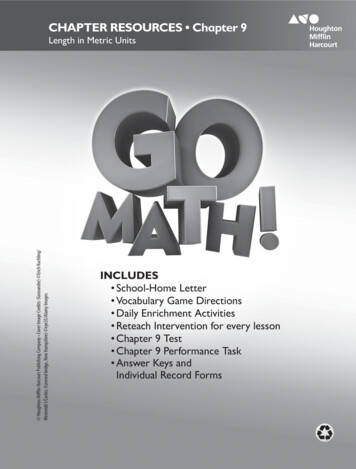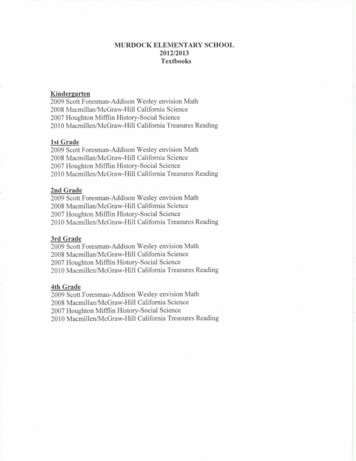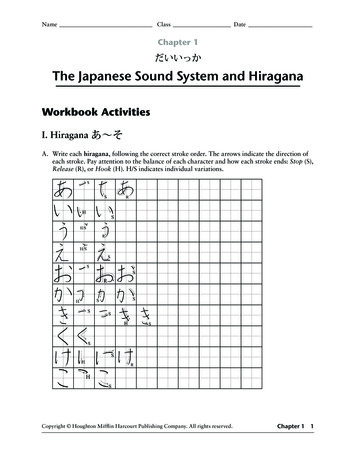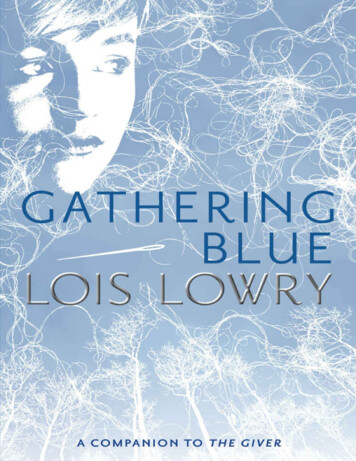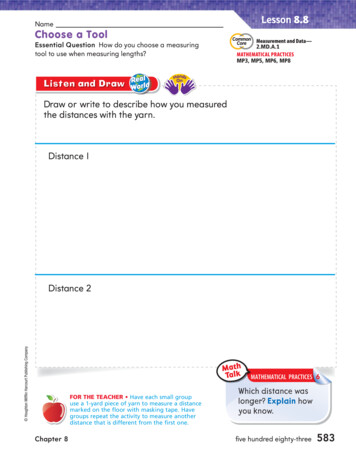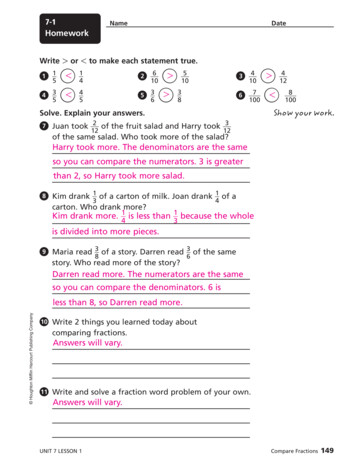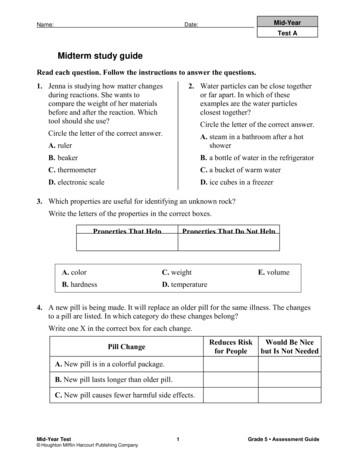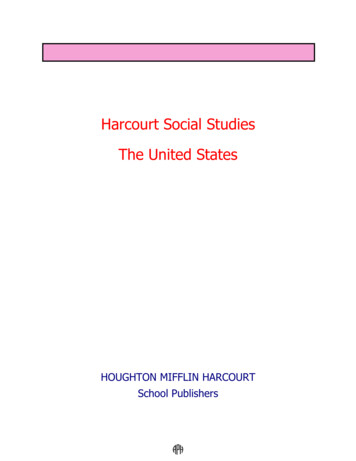
Transcription
Harcourt Social StudiesThe United StatesHOUGHTON MIFFLIN HARCOURTSchool Publishers
Phyllis Mullins Teacher Whitley North Elementary Rockholds, KentuckyKaci Phipps Teacher Bernice Young Elementary Springdale, ArkansasCopyright by Houghton Mifflin HarcourtPublishing Company 2010 EditionAll rights reserved. No part of this work may bereproduced or transmitted in any form or by anymeans, electronic or mechanical, includingphotocopying or recording, or by any informationstorage and retrieval system, without the priorwritten permission of the copyright owner unlesssuch copying is expressly permitted by federalcopyright law. Requests for permission to makecopies of any part of the work should be addressedto Houghton Mifflin Harcourt School Publishers,Attn: Permissions, 6277 Sea Harbor Drive, Orlando,Florida 32887-6777.ISBN-13:978-0-15-385888-8 ISBN-10:0-15-385888-51 2 3 4 5 6 7 8 9 10 0914 18 17 16 15 14 13 12 11 10 09
1A1AUnit 1 The Land and Early PeopleThe Big IdeaGeography People interact with their environmentand are affected by it.What to Know How do the geography and the climate of theUnited States differ from region to region? What was the impact of early North Americancivilizations? How did geography and climate affect NativeAmerican groups?1B-11B-1
7IMAGE DESCRIPTION: A timeline is titled TheLand and Early People. Events comprise: EarlyNative Americans hunt large animals about12,000 years ago; the farming settlement ofJericho is founded in southwest Asia about10,000 years ago; people in Asia began makingpottery about 8,500 years ago; early NativeAmericans begin farming about 5,000 years ago;people in Asia begin training horses about 4,500years ago; the Navajo move to the desertSouthwest about 1,000 years ago; and over30,000 live in Cahokia about 800 years ago.22
PeopleA Navajo familyIMAGE DESCRIPTION: Three members of a Navajofamily are shown, an adult and two children.People of the Southwest and the West Lived in a vast area between the Rocky Mountainsand the Pacific Ocean Included diverse groups of both hunters andfarmers Used a variety of natural resources to build theirhomes
An Iroquois FamilyIMAGE DESCRIPTION: Two adults and twochildren are pictured.Eastern Woodlands People Lived mostly in areas east of the Mississippi Riverin what is now the United States Used wood to make canoes, tools, and shelters Main crops were corn, beans, and squash
33A Makah Hunter IMAGE DESCRIPTION: A person holds a spearand wears clothing made of fur.Northwest Coast People Lived in what is now Canada, Washington, andOregon Skilled whalers and fishers Traveled long distances to tradePlains People Lived in a wide area from what is now Texas toCanada
Main food source was buffaloA Cheyenne CoupleIMAGE DESCRIPTION: A man and woman arepictured.An Arctic Family
13CHAPTER 1 Our Nation’s Geography Grand Teton National Park, WyomingIMAGE DESCRIPTION: A snowy mountainrises behind a forest with lake in foreground.13
1414Lesson 1 States and RegionsWHAT TO KNOW How are the 50 states alike, andhow are they different?VOCABULARYcontiguous p. 15 region p. 15 relative location p. 15 continent p. 18 population p. 18PLACESUnited StatesCanadaMexicoFocus Skill COMPARE AND CONTRASTIMAGE DESCRIPTION: A Venn diagramshows two fields labelled Topic 1 and Topic 2and their overlap field labelled Similar.
You Are ThereYou are in the library in the town of Derby Line,Vermont. It looks like any other town library, but itis not. This library is located in two differentcountries, the United States and Canada.If you stand in one part of the library, you are in thestate of Vermont. If you walk to another part of thelibrary, you are in the province of Quebec. You enterthe library in the United States, but you check outbooks in Canada!
DERBY LINE LIBRARY The black line on the libraryfloor shows where the border between the UnitedStates and Canada lies.IMAGE DESCRIPTION: In one photo, twopeople are seen talking in a library with a blackline on the floor between them. Another photoshows the exterior of the Derby Line Library.
1515A Nation of 50 StatesThe United States is a nation made up of 50 states.Forty-eight of them share at least one border withanother state. They are contiguous(kuhn TIH gyuh wuhs), or next to each other.Two states, Alaska and Hawaii, are separated fromthe other states. Alaska, our northernmost state,shares a border with the country of Canada. Hawaiiis a group of islands in the Pacific Ocean. It is morethan 2,000 miles from the 48 contiguous states.9MAP SKILL PLACE What is the capital of your state?
IMAGE DESCRIPTION: A U.S. map showsnational and state capitals and borders.Regions of the United StatesTo make it easier to talk about different areas of thecountry, people often group the 50 states into fivelarge regions. A region is an area in which manyfeatures are similar.The five regions of the United States are the West,the Southwest, the Midwest, the Southeast, and theNortheast. Each region is based on its relativelocation in the United States. The relative location ofa place is where it is compared to other places. Forexample, the Midwest region is between theNortheast and the West.The states within each region are alike in manyways. The states often have similar kinds of land,and the people who live there often earn their livingin similar ways. The states in each region may alsoshare a history and culture.Reading Check COMPARE AND CONTRAST How arethe states in a region similar?
3131Inlets and LakesHundreds of inlets along the Atlantic and Pacificcoasts help define the shape of the United States. Aninlet is any area of water extending into the landfrom a larger body of water.Gulfs and InletsThe largest inlets are called gulfs. The largest gulfbordering the United States is the Gulf of Mexico.Another large gulf, the Gulf of Alaska, lies south ofAlaska along the Pacific Coast.Hundreds of bays and sounds also shape thecoastline. A sound is a long inlet that separatesoffshore islands from the mainland. The largest baysand sounds provide harbors where ships can safelydock. Most of the country's largest bays and inletsare found along the Atlantic and Gulf coasts.Our Largest LakesThe largest lakes in the United States and in all ofNorth America are together known as the GreatLakes. They are located along the border betweenthe United States and Canada.
These five lakes—Superior, Michigan, Huron, Erie,and Ontario—are among the world's largestfreshwater lakes.LAKE MICHIGAN The city of Chicago lies on theshore of Lake Michigan.IMAGE DESCRIPTION: A sailboat is seen onLake Michigan with the Chicago skyline inthe background.The Great Lakes and the rivers connected to themform an important inland waterway. This waterwaylinks the Midwest and the Atlantic Ocean.Most lakes in the United States are made up of freshwater, but the Great Salt Lake in Utah is as salty asany ocean. Some people even consider it to be asea—an inland body of salt water.
Reading Check: Compare and Contrast How do theGreat Lakes and the Great Salt Lake differ?Fast Fact People in the United States use morethan 40 billion gallons of water from the GreatLakes every day.323215 Major Bodies of Water in the United StatesMAP SKILL LOCATION Which city on the map borders the OhioRiver?IMAGE DESCRIPTION: A U.S. map labels majorbodies of water and shows state and nationalborders and select cities.RiversRivers are bodies of fresh, moving water. Every river
3535Biography Marjory Stoneman Douglas Responsibility“There are no other Everglades in all the world.”Marjory Stoneman Douglas defended theenvironment at a time when many people did notthink about conserving Earth's natural resources.Her books and volunteer work showed people theimportance of protecting the environment, mainlyFlorida's Everglades.
IMAGE DESCRIPTION: A photo shows MarjoryStoneman Douglas. A timeline indicates she wasborn in 1890, published The Everglades: River ofGrass in 1947, formed the volunteer group“Friends of the Everglades” in 1970, and died in1998.Douglas was born in Minneapolis, Minnesota, in1890. When she was 25, she moved to Miami,Florida, to work as a reporter for the Miami Herald.In 1942, she began working on a project aboutAmerican rivers. She published The Everglades:River of Grass in 1947. That same year, the
Everglades became a national park.Douglas's book showed people that the Evergladeswas home to many rare plants and animals that wereworth protecting. In 1970, she formed a volunteergroup called “Friends of the Everglades”. Douglascontinued to travel and give speeches about theEverglades until her death at the age of 108.Why Character Counts How did Marjory Stoneman Douglas help protectthe environment?Go Online For more resources, go towww.harcourtschool.com/ss136Lesson 4 Climate and VegetationWHAT TO KNOW How do climate and vegetationdiffer across the United States?VOCABULARYelevation p. 37 natural vegetation p. 38 arid p. 39 tundra p. 39PLACES36
Rocky MountainsFocus Skill COMPARE AND CONTRASTIMAGE DESCRIPTION: A Venn diagramshows two fields labelled Topic 1 and Topic 2.Their overlap field is labelled Similar.You are There As your horse moves forward to catchup with the group, you feel a rush of cold air. It'scool outside, even though the sun is shiningbright.The Rocky Mountains look huge in thedistance. It's your first visit to Colorado and yourfirst time horseback riding. There is snow on themountains ahead, but the land around you isperfectly green.
THE ROCKY MOUNTAINS Many people participatein outdoor activities, such as horseback riding orsnow skiing, in the Rocky Mountains.IMAGE DESCRIPTION: Several people ride horsesin a queue with a snowy mountain in background.
373716The Four SeasonsILLUSTRATION Seasons change as Earth orbits thesun. When does winter begin in the NorthernHemisphere?IMAGE DESCRIPTION: A diagram explains howEarth’s orbit is responsible for the change of theseasons. Different portions of Earth face the sunover the course of the year. In December theSouthern Hemisphere faces the sun and it iswinter in the Northern Hemisphere. In March thePacific Ocean faces the sun and it is Spring in theNorthern Hemisphere. In September the AtlanticOcean faces the sun and it is Autumn in theNorthern Hemisphere.ClimateThe climate of a place can affect what people wear,what kinds of activities they do, and how they earn
Harcourt Social Studies The United States

